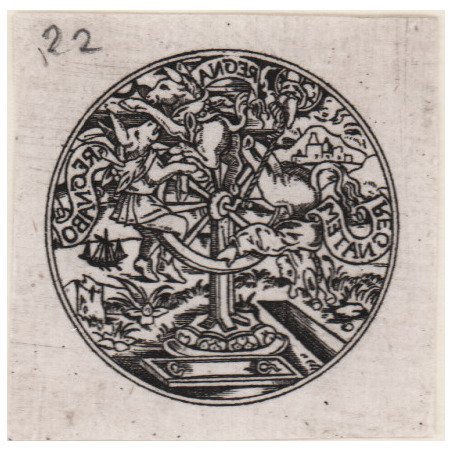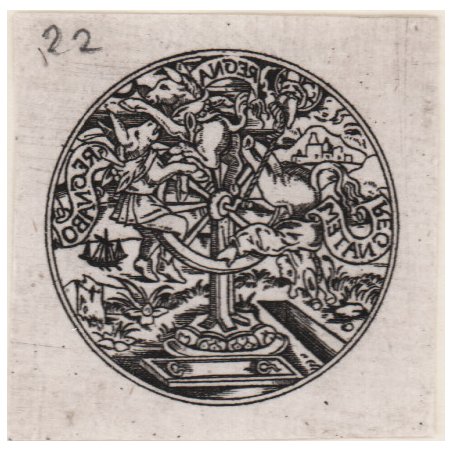Copia di un niello già conservato nella collezione Durazzo (n. 2854), di cui una impressione originale è ' a Berlino, Staatliche Museen. Sui cartigli, in senso orario da sinistra, al contrario: REGNABO, REGNA, REGNATEM. Questo bel lavoro, delicatamente inciso, è caratteristico delle stampe a niello per le sue dimensioni ridotte, la sua forma circolare e la sua iscrizione al contrario, ma non è caratteristico per il suo sfondo bianco e non ombreggiato. Tecnicamente, sembra risalire alla fine del XV o all'inizio del XVI secolo. Il soggetto era comune in tutta l'arte europea dall'alto medioevo in poi ed è spesso accompagnato da varianti delle iscrizioni sopra citate, ciascuna associata a una figura diversa posta a intervalli regolari intorno alla ruota della fortuna. In questa immagine, la ruota è fatta girare da una corda, attaccata a una manovella nel centro e tirata da una mano che emerge dal cielo in alto a destra. La mano sembra emergere da, o passare attraverso, un'aureola inscritta con una croce. La mano, quindi, deve essere la mano di Dio, che determina il destino dell'uomo spingendo la Ruota della Fortuna. I nielli della collezione Durazzo vennero fatti riprodurre in incisioni dal proprietario, tra fine XVIII e inizio XIX secolo, a Venezia - come specificato anche dal Malaspina nel suo catalogo del 1824 - costituendo una serie che venne diffusa e collezionata dagli amatori. Bartsch descrive queste copie nel suo volume edito nel 1811, data che quindi costituisce il terminusine ante quem per l'esecuzione. Copy of a niello print formerly kept in the Durazzo collection (n. 2854), now in Berlin, Staatliche Museen. On the scrolls, clockwise from the left, in reverse: REGNABO, REGNA, REGNATEM. This fine, delicately engraved work is characteristic of niello prints in its diminutive size, its circular shape, and its inscription in reverse, but uncharacteristic in its white, unshaded background. Technically, it appears to date from the late fifteenth or early sixteenth century. The subject was common throughout European art from the high middle ages onward and is often accompanied by variants of the inscriptions quoted above, each one associated with a different figure placed at regular intervals around Fortune’s wheel. In this image, the wheel is turned by a rope, attached to a crank in the center and pulled by a hand emerging from the sky at the upper right. The hand appears to emerge from, or pass through, a halo inscribed with a cross. The hand, therefore, must be the hand of God, who determines man’s fate by propelling the Wheel of Fortune. The nielli of the Durazzo collection were reproduced in engravings by the owner himself, between the end of the 18th and the beginning of the 19th century, in Venice - as also specified by Malaspina in his catalog of 1824 - constituting a series that was circulated and collected by amateurs. Bartsch describes these copies in his volume published in 1811, a date that therefore constitutes the terminus ante quem for the execution. For the attribution to Maso Finiguerra, disputed by some scholars, see the summary in Zucker in The Illustrated Bartch,1993. Cfr. TIB 2401.011; Duchesne, pp. 259-60, n. 312; Zanetti, p. 107, n. 151


Descubre cómo utilizar
Descubre cómo utilizar

